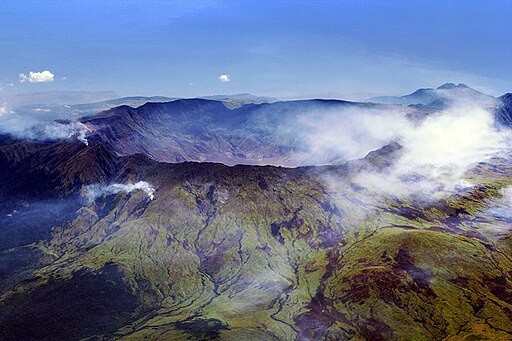Two hundred years ago, millions of people in parts of North America and Europe suffered from failed crops and near-famine conditions. While they did not know the cause at the time, scientists and historians now know that it was due to a volcanic eruption on the other side of the world.

An Epic Volcanic Eruption
On April 10, 1815, a 13,000-foot-high (3,962 meters) volcano on the island of Sumbawa, Indonesia erupted, considered as the largest eruption in recorded history. According to the U.S. Geological Survey, the blast of Mount Tambora was 100 times more powerful than the 1980 eruption of Mount St. Helens which ranked seven on its eight-level volcanic explosivity index. The event led to the death of at least 71,000 people, with up to 12,000 of whom were killed directly by the eruption while the rest died from the disease that spread in the aftermath.
The volcano spewed out enough ash and pumice to cover a square area 100 miles on each side to a depth of almost 12 feet (3.66 meters). The volcanic ash was spread around the world by the jet stream and covered our planet like a great cosmic umbrella which dimmed the Sun's heat.
The eruption injected a huge amount of sulfur dioxide into the stratosphere, where it oxidized to form sulfate aerosols. The volcanic aerosols reduced net shortwave radiation and caused widespread, long lasting surface cooling. It also resulted in a reduction in solar irradiance, which brought record cold to much of the world during the following summer.
The Year Without a Summer
As millions of tons of ash, dust, and sulfur dioxide were released into the atmosphere, the world's climate temporarily changed and the global temperatures dropped by 2 - 7 degrees Fahrenheit. This resulted in a series of weather-related disasters to the environment and to humankind.
On June 6, snow fell in Maine, Dennysville, New York, and Albany. In Cape May, New Jersey, frost was reported five nights in a row in late June, resulting in extensive crop damage. Meanwhile, lake and river ice was seen as far south as northwestern Pennsylvania in July, with frost reported as far south as Virginia on August 20 and 21. Rapid, dramatic changes in temperature also occurred frequently, as temperatures sometimes went from above-normal summer levels to near freezing within hours.
The unusual cold heavily affected agricultural production in many parts of the world, either directly or indirectly. It caused crop failures, famines, dramatic increases in food prices, epidemics of cholera and other diseases, and cultural disruptions. In the U.S., the prices of grains at least quadrupled, and the prices of oats increased almost eightfold.
Meanwhile, looting, arson, riots, and famine also occurred in many European cities. In the other part of the world, China suffered from massive crop failures and disastrous floods. In India, a disruption in the summer monsoon spread a cholera outbreak from the Ganges River all the way to Moscow.
Aside from food shortages, the natural climate change caused outbreaks of diseases and widespread migrations as people looked for a better home. Religious revivals also emerged as people tried to make sense of it all. The disastrous event even spread to the literary world, as the foul, frigid year inspired the plot of Mary Shelly's epic horror novel Frankenstein.
RELATED ARTICLE : Super Volcanic Eruption Happens When Massive Magma Building Up For Millions of Years Rapidly Moves Downward and Suddenly Rises [Study]
Check out more news and information on Volcanic Eruption in Science Times.












